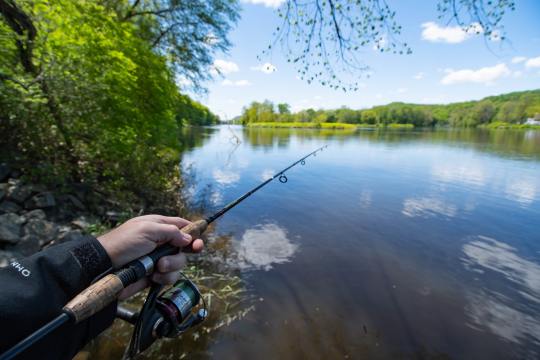Don't wanna be here? Send us removal request.
Text
Mastering the Art of Topwater Fishing: Tips and Tricks
Topwater fishing is an exhilarating technique that adds an element of excitement to your angling experience. The explosive strikes and heart-pounding moments as a fish breaches the surface create memories that linger long after the fishing trip is over. Mastering the art of topwater fishing involves understanding the right techniques, lures, and strategies to entice fish lurking beneath the water's surface. In this guide, we'll explore fishingforbig tips and tricks to elevate your topwater fishing game.
1. Choose the Right Lure
Selecting the right topwater lure is crucial for success. Various types of topwater lures mimic different prey and trigger distinct predatory responses from fish. Consider these popular types:
Popper: This lure features a concave mouth that creates a popping sound when twitched. It imitates injured prey and often attracts aggressive strikes.
Walking Bait: Also known as a "walk-the-dog" bait, it has a side-to-side swimming action when twitched. This mimics a wounded or struggling baitfish, enticing fish to strike.
Buzzbait: With a spinning blade that creates surface disturbance and vibration, the buzzbait imitates a fleeing creature. It's effective in low light or murky water conditions.
Frog: Designed to imitate frogs or other surface-dwelling creatures, frogs excel in dense vegetation. They often feature weedless designs to navigate through lily pads and grass.
Prop Bait: Equipped with spinning propellers, this lure creates a unique disturbance on the water's surface, resembling a struggling or wounded baitfish.

2. Master the Twitch and Pause Technique
Topwater lures are most effective when used with the twitch and pause technique. After casting, impart a series of short twitches to create enticing movements on the water's surface. This action mimics the erratic behavior of injured or distressed prey. Follow each twitch with a pause, allowing the lure to sit momentarily. This pause can trigger aggressive strikes from curious or opportunistic fish. Experiment with the cadence and duration of your twitches and pauses to determine what the fish are responding to on a given day.
3. Time Your Topwater Fishing
Timing is crucial when it comes to topwater fishing. The best opportunities often arise during low-light periods, such as dawn and dusk. Overcast days can extend the topwater bite into the daytime. Fish are more likely to venture into shallower areas during these times, making them more accessible to topwater lures. Additionally, topwater fishing can be highly productive in the spring and fall when fish are more active near the surface.
4. Adjust to Water Conditions
Adapting your topwater fishing approach to the prevailing water conditions enhances your chances of success. In clear water, use more natural-colored lures and employ subtle twitches to avoid spooking fish. In murky or stained water, opt for lures with more significant silhouette and vibration to attract fish from a distance. Pay attention to the presence of structure, such as submerged rocks, logs, or vegetation, as these areas are likely to hold fish.
5. Be Mindful of Your Equipment
Using the right equipment is essential for effective topwater fishing. Choose a rod with a medium to medium-heavy power and a fast action. This allows for accurate casting and better control over the lure. Spinning or baitcasting reels with a high gear ratio are suitable for quick retrieval when working topwater lures. Use monofilament or braided line for increased sensitivity and better control of the lure.
6. Understand Fish Behavior
To master topwater fishing, understanding the behavior of the fish you're targeting is crucial. Different species exhibit varied reactions to topwater lures, and even individual fish may respond differently based on factors like weather conditions and water temperature. Observing the water's surface for signs of fish activity, such as splashes, swirls, or tails breaking the surface, can provide valuable clues about the behavior and location of fish.
7. Practice Catch and Release
Topwater fishing often involves enticing strikes from aggressive fish. To contribute to the sustainability of fish populations, practice catch and release when appropriate. Use barb-less hooks to minimize damage during hook removal, and handle fish with wet hands to protect their slime layer. A healthy catch and release approach ensures that future anglers can enjoy the thrill of topwater fishing.
Conclusion
Mastering the art of topwater fishing adds a dynamic and thrilling dimension to your angling repertoire. By choosing the right lure, mastering the twitch and pause technique, timing your topwater fishing, adjusting to water conditions, being mindful of your equipment, understanding fish behavior, and practicing catch and release, you can increase your success and create lasting memories on the water. Embrace the excitement of topwater fishing, and let each explosive strike be a reminder of the thrill this technique brings to the world of angling. Tight lines and happy topwater fishing!
0 notes